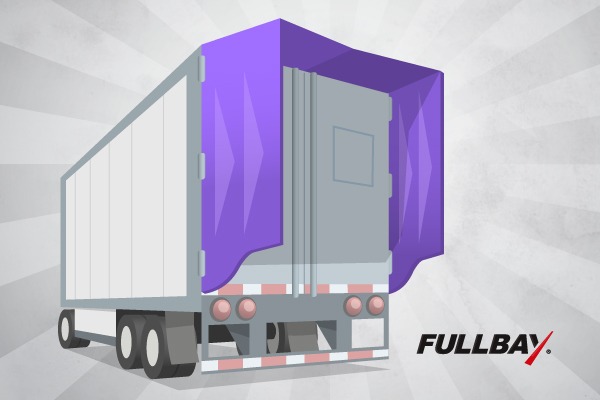Saving Fuel Using Aerodynamics for Your Semi Trailer

Drivers and fleet managers are always on the lookout for ways to make their trucks more profitable. Since fuel is the biggest expense in most fleets’ budgets, it’s little wonder that so much time, effort, and research go into using alternative fuels and making semis more fuel efficient overall. In fact, newer heavy duty trucks are designed with sleek, smooth lines. The design enhances the way trucks handle wind resistance on the road. Plus, it’s routine to fit semi cabs with fairings to further decrease drag. Increasing fuel efficiency doesn’t stop at the cab, however. Logically, making trailers more aerodynamic would increase fuel efficiency even more. The number of semi trailer aerodynamics products popping up on the market proves it’s more than just a novelty. What’s more, the numbers show that the most promising trailer add-ons do, in fact, improve fuel efficiency.
How Heavy Duty Truck Engines Consume Fuel
To fully appreciate why you should care about semi trailer aerodynamics, you need to understand fuel burn on the open road. You don’t have to be a physicist to know that a moving truck experiences resistance from the air around it, even when there’s little to no wind. It’s called aerodynamic drag, and the faster a semi goes, the more resistance there is.
Furthermore, when you hook up a trailer, the problem multiplies. The wind resistance doesn’t just hit the front of the truck. It also lodges in the space between the truck and the front of the trailer, swirls around beneath the trailer, and creates a low-pressure vacuum behind it that literally pulls the entire vehicle in the opposite direction it’s traveling. In addition to reducing fuel efficiency, turbulence can cause trailers to sway, fishtailing back and forth. That not only interferes with the handling of the truck and trailer, but also contributes to driver stress.
Ultimately, drag accounts for more than 65 percent of the fuel a truck consumes on the highway. You might as well set fire to your budget and watch it burn, and that’s just what it feels like to many owner-operators and fleet managers. Installing add-ons to truck and trailer can reduce drag enough to create fuel savings of anywhere from 2 to 12 percent depending on which device you use. What’s more, installing more than one add-on can increase savings even more.
Trailer Add-Ons for Aerodynamic Gains
Even though trucks are now built for optimal aerodynamics, trailers still pose a problem. Semi trailer aerodynamics is the solution, but it’s one that some fleets balk at. First, there’s the cost. Naturally, that varies, with the price tag on some products being in the low hundreds and others costing over $2,000. Another issue is that there’s no clear best add-on out there. Because of varying driving conditions, what works great for one fleet might not work as well for another. Plus, any device you install on a trailer will increase the overall weight. That’s a fact that is in direct opposition to every manager’s goal to reduce tractor-trailer weight. Plus, it seems adding weight would cancel out any savings you could possibly gain by reducing drag.
However, the numbers say trailer add-ons are worth it, saving some drivers $500 or more each month. What’s more, the added stability and improved handling the devices offer reduce driver fatigue. Although no specific product has emerged as the best, there are a number of different add-ons available, and the market is growing. Since multiple devices increase savings, individual drivers and fleets can choose to install whatever works best for them based on what they are willing to spend. Considering the cost of diesel fuel, even a modest savings of 1 to 2 percent coupled with less stress makes semi trailer aerodynamics worth a try.
Semi Trailer Aerodynamics Systems
So, what’s available? A report by the North American Council for Freight Efficiency notes that semi trailer aerodynamics systems tend to focus on one of three areas:
- the gap between the truck and trailer
- the rear of the trailer
- the trailer’s underbody
Most people are familiar with skirts, also known as fairings, as a routine remedy for wind resistance. Attached to the underbody of trailers, they block air from getting underneath it. Aerodynamic mud flaps are another common fix for drag. Let’s take a look at some of the other add-ons out there.
Tail Panels
Companies like Stemco sell panel systems that attach to trailers at the back. The panels slope inward to direct airflow smoothly away from the trailer, preventing the turbulent vacuum that tugs the vehicle backward. Total panel weight varies, depending on manufacturer and style of panels you get. The most efficient ones Stemco offers weigh 185 pounds. Used alone, with no other semi trailer aerodynamics, the company claims their panels increase fuel efficiency by 5.54 percent. The cost is around $2,000.
Nose Cones
Made from fiberglass, lightweight Nose Cones address the gap problem between the truck and trailer. Plus, the rounded shape deflects air from all angles, so even crosswinds won’t interfere with their effectiveness. Nose Cone Aerodynamics claims their add-on increases fuel efficiency by 2 to 10 percent. Depending on what model you get, Nose Cones can cost up to $1,800.
Airtabs
At just $200 per kit, Airtab wishbone add-ons are possibly the most economical of semi trailer aerodynamics. What’s more, they’re small and lightweight, so the weight they add to the trailer is insignificant. Created by a former racecar driver, the wishbone-shaped adhesive tabs are applied to the top and both sides of the rear of the trailer, with the tapered end pointing toward the back of the vehicle. They are also effective when applied to the trailing edges of truck skirting. As air hits the wide, open end of the wishbone, it’s compressed into a small bunch, like when you ball a piece of paper between your hands. The swirling bundles of air exit the narrow end of the Airtabs with low resistance. Actual users have reported saving 4 to 8 percent on fuel.
In the Works
In addition to the add-ons listed above, engineers, researchers, and even truck drivers are working on other solutions to semi trailer aerodynamics. Those include:
- An underbody panel that covers up the crossmembers, main beams, landing gear, and other things under trailers that do battle with winds, causing turbulence and drag.
- An inflatable boattail that works like tail panels but these are bulbous and collapsible. They can be inflated in 30 seconds and deflate quickly, too, to lie flat when trailer doors are opened and secured.
- A kit that combines a specially designed skirt and blow fans that blow wind from niches near the back corners of the trailer to disburse air and prevent a vacuum from forming there.
And that’s just to mention a few. In light of the fuel savings that can be gained, it’s worth the time to look into the different semi trailer aerodynamics options. Choose the one or ones that will work best for you, but continue to keep an eye open for the new products, as well.

